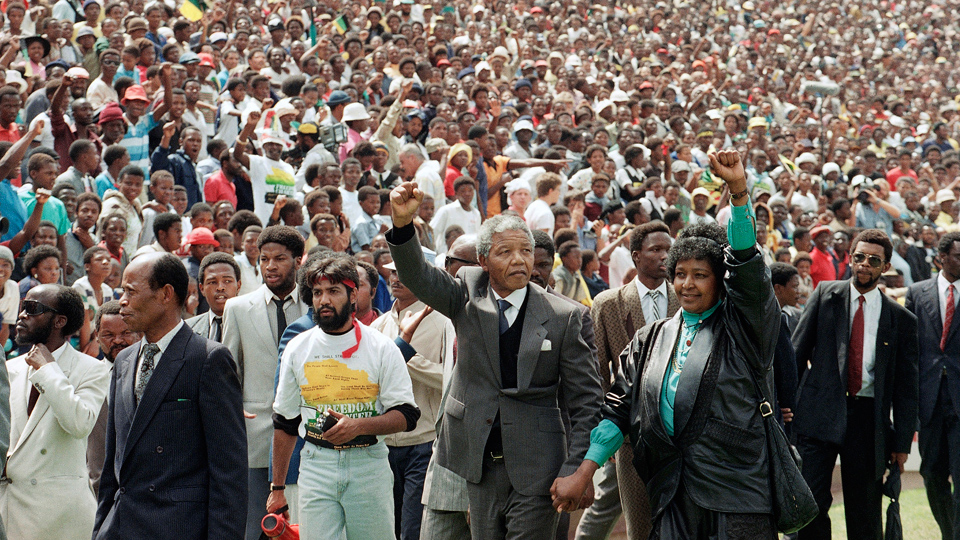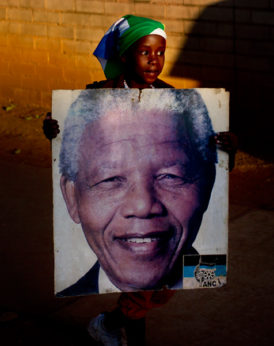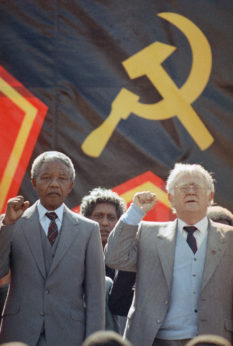
The following article on the life of South African anti-apartheid leader and former President Nelson Mandela was originally published in People’s World at the time of his death in December 2013. We republish it now in honor of the centennial of his birth.

Nelson Rolihlahla Mandela was born on July 18, 1918 in Mvezo, South Africa, into a branch of the royal family of the Tembu people. The name Rolihlahla means “stirring up trouble”; the name Nelson was given to him by a mission school teacher. In South Africa, Mandela was universally known by his clan name, Madiba.
Mandela spent an idyllic childhood first at his mother’s ancestral household at Qunu, and later at the court of Chief Jongintaba Dalindyebo, his kinsman and regent for the Tembu king. Jongintaba assured Mandela’s enrollment in Fort Hare University in the Eastern Cape. But when the young man caught wind of a political marriage Jongintaba was arranging for him, he fled to Johannesburg, where he briefly worked as a watchman. Later, he was signed on as a clerk in a white law firm.
In Johannesburg, Mandela made contact with leaders of South Africa’s freedom movement including the African National Congress (ANC) and the South African Communist Party (SACP). His law studies were frequently interrupted by growing involvement in the struggle against the racial injustice.
Mandela originally thought the Communist Party overemphasized class versus racial oppression. In 1944, he and Anton Lembede founded the African National Congress Youth League, which pushed its parent organization toward both a more militant and a more Africanist program. Subsequently, Mandela rose to top leadership in the ANC.
In the elections of 1948, the United Party of Prime Minister Jan Smuts was defeated by a fascist and racist coalition headed by Dr. Daniel Malan. Malan’s National Party government took existing racism to a new extreme, introducing the apartheid (apartness) legal framework which eventually turned South Africa into a pariah state. Mandela and the African National Congress began to advocate strikes, direct action and civil disobedience, while at the same time Mandela rethought his willingness to work through multiracial united fronts and with communists.
In 1950, Parliament passed the Suppression of Communism Act, followed by the Public Safety Act in 1953. Police now had legal mechanisms to classify people as “statutory communists”, jail them for their associations, and ban them from writing and speaking to the public. The Communist Party and the ANC were declared illegal. Mandela was arrested in 1952 and prosecuted for communism along with others. He was given a suspended sentence and a six-month ban from political activity. He also opened a Johannesburg law firm specializing in social justice cases, in partnership with ANC leader Oliver Tambo in 1953.
In 1955, the ANC initiated the Congress of the People, a gathering of 3,000 in Kliptown, near Johannesburg. It brought together the ANC, the South African Indian Congress, the Coloured People’s Congress, the Congress of Democrats, and the South African Congress of Trade Unions (SACTU), and produced the Freedom Charter, which laid out the vision of a multiracial and democratic South Africa and in which the first steps toward socialism could be discerned.
The government reacted by increasing repression. Mandela and many other leading ANC figures were arrested for “high treason.” In 1961, all defendants were acquitted.
But tensions were heating up as the ANC and also the nationalist Pan African Congress (PAC) campaigned to end the law requiring all Africans to carry government passes which had to be presented to police on demand. In 1960, police fired on a PAC organized anti-pass demonstration at Sharpeville, killing 69 unarmed people. Mandela hastened to reorganize the ANC with a clandestine component to better resist repression. At this point Mandela, working closely with the Communist Party, formed an armed resistance group called Umkhonto we Sizwe, Spear of the Nation or MK. MK bombed a number of symbolic targets while trying to avoid civilian casualties. Mandela toured Africa rounding up support for the new phase of the struggle.
But Mandela was captured, many believe with CIA help, while traveling in 1962, and sentenced to five years imprisonment. Then in July 1963, police raided Liliesleaf Farm outside Johannesburg and not only rounded up a number of activists but also found documents on MK. The resulting “Rivonia” trial, for sabotage and conspiracy to overthrow the government by violence, led to life sentences for Mandela and others.
The longest part of the sentence was served doing hard labor on chilly, windswept Robben Island off the coast of Capetown. Conditions led to Mandela contracting a tuberculosis infection which left him with damaged lungs for the rest of his life. Mandela quickly established leadership over the heterogeneous group of political prisoners, organizing study groups and general, vocational and political education classes.
Meanwhile Mandela’s family, back on the mainland, were undergoing great trials. He had divorced his first wife, Evelyn Ntoko Mase, in 1958, and married social worker Winnie Madikezela shortly thereafter.
The struggle in South Africa intensified, especially with the Soweto Rebellion of 1976. The “Free Mandela” campaign took off, stimulated by the journalism of Soweto journalist Percy Qoboza. More prisoners were sent to Robben Island, and Mandela took them under his wing also.
Eventually, the regime, pressured from inside and out, offered release to Mandela if he would renounce violence and split with his communist allies, but he refused these arrangements as dishonorable. Mandela was transferred from Robben Island to Pollsmoor Prison in Capetown, and in 1988, after a bout with tuberculosis, he was transferred again to Victor Verster prison near Paarl.

In 1989, the new president, F.W.de Klerk came to the conclusion that the apartheid system could not be sustained. In 1990, de Klerk released Mandela and other remaining prisoners, and legalized the ANC, the Communist Party, and all other banned groups.
Receiving a rapturous reception from the people, Mandela set to work organizing an international campaign aimed at ending the entire apartheid system. In 1991, Mandela was elected president of the ANC in succession to Oliver Tambo.
But violence continued, with bloody confrontations in Kwazulu-Natal and elsewhere between ANC members and members of the Inkatha organization headed by Zulu leader Mangosuthu Buthelezi. Mandela’s relations with de Klerk deteriorated, partly because a government sponsored “third force” was inciting the conflicts. Talks between the ANC and the government in 1991 and 1992 took on a sharply combative tone. In 1993, Mandela and de Klerk were jointly awarded the Nobel Peace Prize.
In 1994, South Africa’s first ever democratic, non-racial general election was held, with Mandela as the ANC presidential candidate. Mandela and the ANC triumphed with 62 percent of the vote.
Mandela served as president of South Africa from 1994 to 1999. His main concerns were to destroy the institutions of apartheid and racial justice, to calm interracial tensions, and to improve the living standards of the mass of his people. In this, he scored notable successes in electrification, housing, labor rights and health care. Of special note is his Truth and Reconciliation Commission, chaired by Archbishop Desmond Tutu and designed to create closure on the crimes of the apartheid period.
However, Mandela’s liberation and election to the presidency came right after the collapse of Soviet and Eastern European socialism. He did not move toward the more radical goals enshrined in the Freedom Charter, such as the nationalization of the mines, the banks and monopolistic industries. Mandela and his advisors felt that international monopoly capital was in too strong a position worldwide for such things to be feasible, and rather turned to policies to attract foreign private investment. These political choices are the subject of controversies in South Africa to this day.
Mandela stepped down after his first term, and was succeeded by Thabo Mbeki. Mandela then devoted himself to both international and national peace and social justice efforts. He set up a number of charitable organizations, and spoke out publicly against injustices and violent acts such as the Iraq war. Mandela spoke openly about the death of his son Magkatho, from AIDS in 2005, in an attempt to win public solidarity for other sufferers.
Fatigued because of his 89 years and because of the health problems caused by his 27 years incarceration, one of Mandela’s last public projects was “the Elders”, a group of elder statespersons from all over the world who speak out on social justice issues, created in 2007.
Mandela had divorced Winnie Madikizela in 1992, and married Graça Machel, widow of Mozambican President Samora Machel, in 1998.
Mandela had four children by his first wife, Evelyn, of whom only his daughter Mazikawe survives. Another daughter died in infancy, a son, Thembekile, was killed in an auto crash in 1969, and another son, Magkatho, died of AIDS complications in 2005. He had two daughters by Winnie Mandela, Zindzi and Zenani. Magkatho’s son Mandla has taken on what would have been Nelson Mandela’s traditional chiefly role in the Mvezu Traditional Council.
Nelson Mandela wrote numerous books and articles, including Long Walk to Freedom (1994, Little, Brown and co.) and Conversations with Myself (with Richard Stengl, 2010 MacMillan). His autobiography was made into a film released in 2013.
Like free stuff? So do we. Here at People’s World, we believe strongly in the mission of keeping the labor and democratic movements informed so they are prepared for the struggle. But we need your help. While our content is free for readers (something we are proud of) it takes money — a lot of it — to produce and cover the stories you see in our pages. Only you, our readers and supporters, can keep us going. Only you can make sure we keep the news that matters free of paywalls and advertisements. If you enjoy reading People’s World and the stories we bring you, support our work by becoming a $5 monthly sustainer today.












Comments